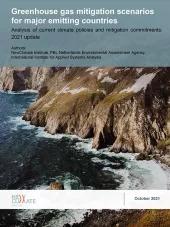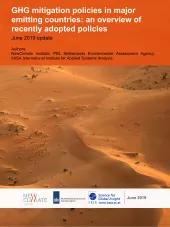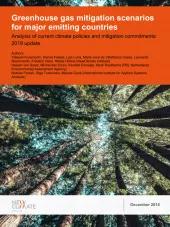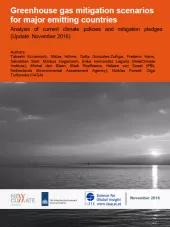This report presents an overview of recently adopted climate policies, climate-relevant responses to the COVID-19 pandemic and a state of play of NDC and LTS submissions in 25 countries and regions. The policy information compiled by NewClimate Institute, PBL Netherlands Environmental Assessment Agency and the International Institute for Applied Systems Analysis (IIASA) is an update of a previous report published in June 2019, and supplements the December 2019 report on the projected greenhouse gas (GHG) emissions under currently implemented policies and mitigation commitments.
Main Findings:
The 2020 update report contains three sections with information on the following for 25 selected countries:
- An overview of recent mitigation policies across all sectors
- An overview of COVID-19 response measures, complemented with selected “green” and “grey” measures screened for climate impact
- A state of play on updated Nationally Determined Contributions (NDC) and Long-Term Strategies (LTS)
This report includes over 60 mitigation policies that were adopted or under development between July 2019 and August 2020. Our analysis shows higher policy activity in the energy sector (25 entries), followed by the transport sector (12 entries), land use, land use change and forestry (eight), buildings (two), and agriculture (one). There were also 16 new cross-sectoral policies. This time no new policies were noted in the industry and waste sectors. Most policy developments are expected to contribute to GHG emissions reductions; however, we have also identified explicit policies that could increase GHG emissions in at least four countries. These include the expansion of fossil fuel exploration in Colombia, a stimulus to palm oil biodiesel production in Indonesia, potential mining in protected area in Brazil, and several proposed rollbacks of legislations and regulations set under the previous administration in the United States.
The report also provides an overview of COVID-19 response measures implemented in the 25 countries and regions and, where possible, identifies sustainable “green” measures and unsustainable “grey” measures. Our assessment indicates that, with exceptions of the EU and Republic of Korea, most countries have not implemented explicitly “green” recovery measures. Countries are expected to formulate or submit their updated NDCs and long-term strategies well in advance of COP26 in 2021. Of the 25 countries assessed here, only Vietnam has officially revised its NDC target, whereas Japan resubmitted its original NDC target in March 2020. The European Commission has proposed a strengthened target for the EU of 55% emissions reduction below 1990 levels by 2030 (compared to 40% previously), but this target is yet to be approved. Of the countries assessed, five have submitted their long-term strategies to the UNFCCC and five have developed drafts or domestically adopted strategies. Two of them, Japan and the EU, have submitted their long-term strategies with net-zero targets; Japan aims to achieve a decarbonised society as early as possible in the second half of this, while the EU aims for net-zero GHG emissions by 2050. In September 2020, China announced it would aim for net-zero carbon emissions by 2060—this objective has yet to be turned into a long-term strategy target. The 25 countries and regions assessed in this document are: Argentina, Australia, Brazil, Canada, China, Colombia, Egypt, Ethiopia, the European Union, India, Indonesia, Iran, Japan, Mexico, Morocco, Republic of Korea, the Russian Federation, South Africa, Saudi Arabia, Thailand, Turkey, Ukraine, the United Arab Emirates, the United States and Vietnam.










